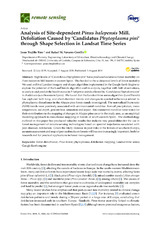Mostrar el registro sencillo del ítem
Analysis of Site-dependent Pinus halepensis Mill. Defoliation Caused by ‘Candidatus Phytoplasma pini’ through Shape Selection in Landsat Time Series
| dc.contributor.author | Trujillo-Toro, Jesús | |
| dc.contributor.author | Navarro Cerrillo, Rafael M. | |
| dc.date.accessioned | 2019-09-02T11:26:45Z | |
| dc.date.available | 2019-09-02T11:26:45Z | |
| dc.date.issued | 2019 | |
| dc.identifier.uri | http://hdl.handle.net/10396/18947 | |
| dc.description.abstract | High levels of ‘Candidatus Phytoplasma pini’ have produced extensive forest mortality on Pinus halepensis Mill forests in eastern Spain. This has led to the widespread levels of forest mortality. We used archival Landsat imagery and shapes algorithm implemented in the Google Earth Engine to explore the potential of the LandTrendr algorithm and its outputs, together with field observations, to analyze and predict the health status in P. halepensis stands affected by ‘Candidatus Phytoplasma pini’ in Andalusia (south-eastern Spain). We found that the Landsat time series algorithm (LandTrendr) has captured both long- and short-duration trends and changes in spectral reflectance related to phytoplasma disturbance in the Aleppo pine forest stands investigated. The normalized burn ratio (NBR) trends were positively associated with environmental variables: Annual precipitation, mean temperature, soil depth, percent base saturation and aspect. Environmental variables were tested for their contributions to the mapping of changes in Aleppo pine cover in the study area, as an empirical modeling approach to disturbance mapping in forests of south-eastern Spain. The methodology outlined in this paper has produced valuable results that indicate new possibilities for the use in forest management of remote-sensing technologies based on spectral trajectories associated with pest-diseases defoliation. Given the likely increase in pest risks in the forests of southern Europe, accurate assessment and map of pest outbreaks on forests will become increasingly important, both for research and for practical applications in forest management. | es_ES |
| dc.format.mimetype | application/pdf | es_ES |
| dc.language.iso | eng | es_ES |
| dc.publisher | MDPI | es_ES |
| dc.rights | https://creativecommons.org/licenses/by/4.0/ | es_ES |
| dc.source | Remote Sensing 11(16), 1868 (2019) | es_ES |
| dc.subject | Forest disturbance | es_ES |
| dc.subject | Pinus forest | es_ES |
| dc.subject | Phytoplasma | es_ES |
| dc.subject | Defoliation mapping | es_ES |
| dc.subject | Landsat time series | es_ES |
| dc.subject | Google Earth engine | es_ES |
| dc.title | Analysis of Site-dependent Pinus halepensis Mill. Defoliation Caused by ‘Candidatus Phytoplasma pini’ through Shape Selection in Landsat Time Series | es_ES |
| dc.type | info:eu-repo/semantics/article | es_ES |
| dc.relation.publisherversion | http://dx.doi.org/10.3390/rs11161868 | es_ES |
| dc.relation.projectID | Gobierno de España. CGL2017-86161-R | es_ES |
| dc.relation.projectID | Gobierno de España. 641762 | es_ES |
| dc.relation.projectID | Gobierno de España. UCO-1265298 | es_ES |
| dc.rights.accessRights | info:eu-repo/semantics/openAccess | es_ES |

